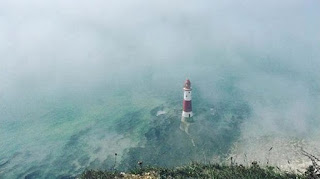The plan was to go from Eastbourne to Newhaven, via Beachy Head, a voyage of about 15 miles along the Sussex Coast.
I was to start one hour before Dover high tide and planned to take about five hours, passing Beachy Head at about slack water.
The sea state was calm and there was a very gentle wind from the Southeast, so it looked like a smooth voyage for PicoMicroYacht.
PicoMicroYacht was rigged at the Eastbourne Sovereign Sailing club and as I put the masts up I chatted briefly with Mick Harper, the club Vice President,.
Looking at the chart, I realised that there was an inside passage past Beachy Head, going inside a race, as indicated by the chart. But a local sailor advised not going too close past Beachy Head because of an underwater reef that juts out from there.
So I decided to take a wide berth and go approximately outside the race area. Nevertheless, on the way from Eastbourne I went quite close to the Hollywell Bank seen on this map in the centre.
I could see a stationary bow wave from a passing ship breaking on this bank about a hundred metres away from me. I sat there observing the phenomenon.
As I got opposite the Beachy Head lighthouse, I realised a ship had gone ahead using the inner passage. Further out the sea was choppy, as I rowed just outside the race area.
A military helicopter flew along the cliffs and just over the lighthouse. I wondered what exercise it was on.
Moving on, I looked back at the high Beachy Head. As Nicholas Crane has said 'chalk is one of England's emblems' and the cliffs round here are as iconic as the white cliffs of Dover.
Onwards, I saw the Seven Sisters, the set of cliffs between Beachy Head and the charming small cove, Cuckmere Haven, in the distance.
Soon I was approaching Newhaven and passing Seaford, with its Martello Tower, a defensive fort built between 1806 and 1810 to protect England from the Napoleonic French. The one rotating cannon was facing out to sea as it would have been all those years ago.
The long pier of Newhaven was infront of me, with the sun setting in the west.
Newhaven is a working port and there were many ships moving around, including those ferrying worker to the new wind farm further down the coast, the cross channel ferry and the fishing boats.
There was a twist to this story. Two days later, a chemical toxic haze rolled in from the sea covering the area I had rowed through. It brought nausea, sore eyes and hospital treatment for about 150 people. I dread to think what it would have been like breathing in the fumes and trying to row..
It remains a mystery as to the cause, but I was so glad I was at the wrong place at the right time on this occasion.
























